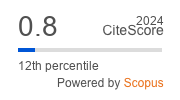Study of vacancy migration as a function of boron substitution in carbon nanolayers
https://doi.org/10.17073/1609-3577-2016-4-249-253
Abstract
Studies of ionic conductivity and structures in which it can be achieved are of great importance for the development of modern batteries. The use of new materials will allow avoiding such typical disadvantages of batteries as short service life, low capacity and leaks. In this article we present the results of our study of the ionic conductivity in boron carbon nanolayers. We have simulated three types of boron carbon nanolayers containing different amounts of boron. The studies have been carried out using the MNDO method within the framework of the molecular cluster model and the DFT method with the B3LYP functional and the 6−31G basis. To study the ion conduction process we have simulated vacancy formation for each type of the nanolayers and studied the energy and electronic characteristics of these processes. We show that 25 % boron substitution is the most energetically favorable for vacancy formation. We have also simulated vacancy migration and determined the thermal conductivity as a function of temperature.
About the Authors
S. V. BorozninRussian Federation
Sergey V. Boroznin — Cand. Sci. (Phys.−Math.), Associate Professor.
100 Universitetskii Prospekt, Volgograd 400062.
I. V. Zaporotskova
Russian Federation
Irina V. Zaporotskova1 — Dr. Sci. (Phys.−Math.), Professor, Director of the Institute of Priority Technologies.
100 Universitetskii Prospekt, Volgograd 400062.
References
1. Kumar P. P., Yashonath S. Ionic conduction in the solid state. J. Chem. Sci., 2006, vol. 118, no. 1, pp. 135—154. DOI: 10.1007/BF02708775
2. Zaporotskova I. V. Uglerodnye i neuglerodnye nanomaterialy i kompozitnye struktury na ikh osnove: stroenie i elektronnye svoistva [Carbon and uncarbon nanomaterials and composite structures on their base: structure and electronic properties]. Volgograd: VolGU, 2009. 490 p. (In Russ.)
3. Yafang Xue, Qian Liu, Guanjie He, Kaibing Xu, Lin Jiang, Xianghua Hu, Junqing Hu. Excellent electrical conductivity of the exfoliated and fluorinated hexagonal boron nitride nanosheets. Nanoscale Research Letters, 2013, vol. 8, p. 49(1−7). DOI: 10.1186/1556-276X-8-49
4. Islam M. M., Bredow T., Heitjans P. The ionic conductivity in lithium−boron oxide materials and its relation to structural, electronic and defect properties: insights from theory. J. Phys.: Condens. Matter., 2012, vol. 24, no. 20, p. 203201. DOI: 10.1088/0953-8984/24/20/203201
5. Roll M. F. Ionic borohydride clusters for the next generation of boron thin−films: Nano−building blocks for electrochemical and refractory materials. J. Mater. Res., 2016, vol. 31, no. 18, pp. 2736—2748. DOI: 10.1557/jmr.2016.261
6. Maier J. Nanoionics: ion transport and electrochemical storage in confined systems. Nature Materials, 2005, vol. 4, рр. 805—815. DOI: 10.1038/nmat1513
7. Cohen M. L ., Zettl A. The physics of boron nitride nanotubes. Physics Today, 2010, vol. 63, no. 11, pp. 34—38. DOI: 10.1063/1.3518210
8. Bezugly V., Kunstmann J., Grundkötter−Stock B., Frauenheim T., Niehaus T., Cuniberti G. Highly conductive boron nanotubes: Transport properties, work functions, and structural stabilities. ACS Nano, 2011, vol. 5, iss. 6, pp. 4997—5005. DOI: 10.1021/nn201099a
9. Fuentes G. G., Borowiak−Palen E., Knupfer M., Pichler T., Fink J., Wirtz L., Rubio A. Formation and electronic properties of BC3 single−wall nanotubes upon boron substitution of carbon nanotubes. Phys. Rev. B, 2004, vol. 69, no. 24, p. 245403. DOI: 10.1103/PhysRevB.69.245403
10. Miyamoto Y., Rubio A., Louie S. G., Cohen M. L. Electronic properties of tubule forms of hexagonal BC3. Phys. Rev. B, 1994, vol. 50, no. 24, pp. 18360—18366. DOI: 10.1103/PhysRevB.50.18360
11. Jana D., Sun C.−L., Chen L.− C., Chen K.−H. Effect of chemical doping of boron and nitrogen on the electronic, optical, and electrochemical properties of carbon nanotubes. Progress in Materials Science, 2013, vol. 58, no. 5, pp. 565—635. DOI: 10.1016/j.pmatsci.2013.01.003
12. Wang R., Zhang D., Zhang Y., Liu Ch. Boron−doped carbon nanotubes serving as a novel chemical sensor for formaldehyde. J. Phys. Chem. B, 2006, vol. 110, no. 37, pp. 18267—18271. DOI: 10.1021/jp061766+
13. Yung−Ta Li, Tei−Chen Chen. Effect of B/N co−doping on the stability and electronic structure of single−walled carbon nanotubes by first−principles theory. Nanotechnology, 2009, vol. 20, no. 37, p. 375705. DOI: 10.1088/0957-4484/20/37/375705
14. Zeng H., Zhi C., Zhang Z., Wei X., Wang X., Guo W., Bando Y., Golberg D. «White graphenes»: Boron nitride nanoribbons via boron nitride nanotube unwrapping. Nano Lett., 2010, vol. 10, no. 12, pp. 5049—5055. DOI: 10.1021/nl103251m
15. Dewar M. J. S., Thiel W. Ground states of molecules. 38. The MNDO method. Approximations and parameters. J. Amer. Chem. Soc., 1977, vol. 99, no. 15, pp. 4899—4907. DOI: 10.1021/ja00457a004
16. Boroznin S. V., Perevalova E. V., Zaporotskova I. V., Polikarpov D. I. Electronic structure and characteristics of some types of boron containing nanotubes. Vestnik VolGU. Seriya 10: Innovatsionnaya deyatelnost = Science Journal of Volgograd State University. Technology and innovations, 2012, no. 6, pp. 81—86. (In Russ.)
17. Pavlov P. V., Hohlov A. F. Fizika tverdogo tela [Solid state physics]. Moscow: Vysshaya shkola, 2000. 494 p. (In Russ.)
18. Ivanovskii A. L. Kvantovaya khimiya v materialovedenii: Nanotubulyarnye formy veshchestva [Quantum chemistry in materials. Nanotubular forms of matter]. Ekaterinburg: Institute of Solid State Chemistry, Ural Branch of the Russian Academy of Sciences, 1999. 176 p. (In Russ.)
Review
For citations:
Boroznin S.V., Zaporotskova I.V. Study of vacancy migration as a function of boron substitution in carbon nanolayers. Izvestiya Vysshikh Uchebnykh Zavedenii. Materialy Elektronnoi Tekhniki = Materials of Electronics Engineering. 2016;19(4):249-253. (In Russ.) https://doi.org/10.17073/1609-3577-2016-4-249-253





































